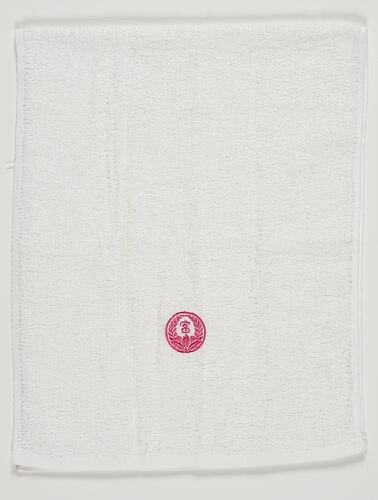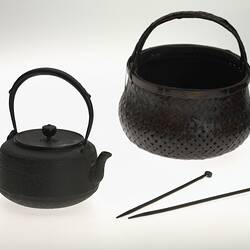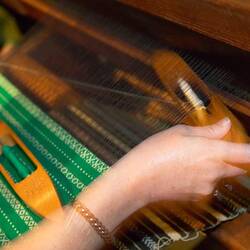Summary
White cloth ('chakin' in Japanese) used as part of the traditional Japanese tea-ceremony. It was brought to Australia by Masumi Hiraga Jackson when she migrated to Australia in 1985.
Masumi Hiraga Jackson was born in Nirasaki, Japan in 1935, one of ten children. Her mother Kino was a skilled weaver who wove and sewed silk kimono, a highly regarded skill. Masumi studied at universities in Tokyo (Japanese cultural studies) and Canberra (English and linguistics) and in 1984 married an Australian. She immigrated to Melbourne in 1985 but sadly her husband died two years later. Masumi decided to remain in Australia and immersed herself in traditional Japanese cultural practices such as Noh theatre, Ikebana and Shimotske paper doll-making. She performs and instructs these art forms in Australia and overseas, and returns to Japan every year to see her family, undertake Ikebana lessons, practise her Noh performance and to purchase materials for doll-making.
Physical Description
Medium sized white terry toweling cloth. Embroidered at one end with round Japanese insignia in red.
Significance
This is part of a beautiful and significant collection of cultural items which represent a range of themes, primarily pertaining to cultural maintenance as a result of the act of migration. The kimonos (unrepresented in the museum's clothing or costume collections) are a mix of brought memory objects from country of origin and traditional Japanese performance costume used in Melbourne. The dolls are a traditional Shimotske paper doll form which has been practised by the donor in Melbourne for nearly 20 years. The teamaking items, also brought migration objects, symbolise the donor's desire to extend traditional Japanese teamaking ceremony in Melbourne where she found it was in little evidence in the 1980s.
This collection enables us to introduce Japanese material into the collection of which there is currently very little. The collection also fits very well within the Immigration and Artistic Practice collection which explores how artists have maintained, adapted, rejected and evolved their various artistic forms as a result of the act of migrating. It provides a counterpoint to the artistic activity from Naomi Ota, the Japanese textile sculptor represented in the Immigration and Artistic Practice Collection, who produces experimental pieces which are in response to the Australian landscape.
More Information
-
Collection Names
-
Collecting Areas
-
Acquisition Information
Donation from Mrs Masumi Hiraga, 21 Mar 2007
-
Place Made
-
User
Mrs Masumi Hiraga, Melbourne, Victoria, Australia, 1985-2007
-
Classification
Cultural identity, Ethnicity - cultural practices, Food & drink production
-
Category
-
Discipline
-
Type of item
-
Object Measurements
842 mm (Length), 323 mm (Width)
-
Keywords
Cultural Maintenance, Cultural Traditions, Food & Drink Preparation, Japanese Communities, Japanese Culture, Japanese Immigration


